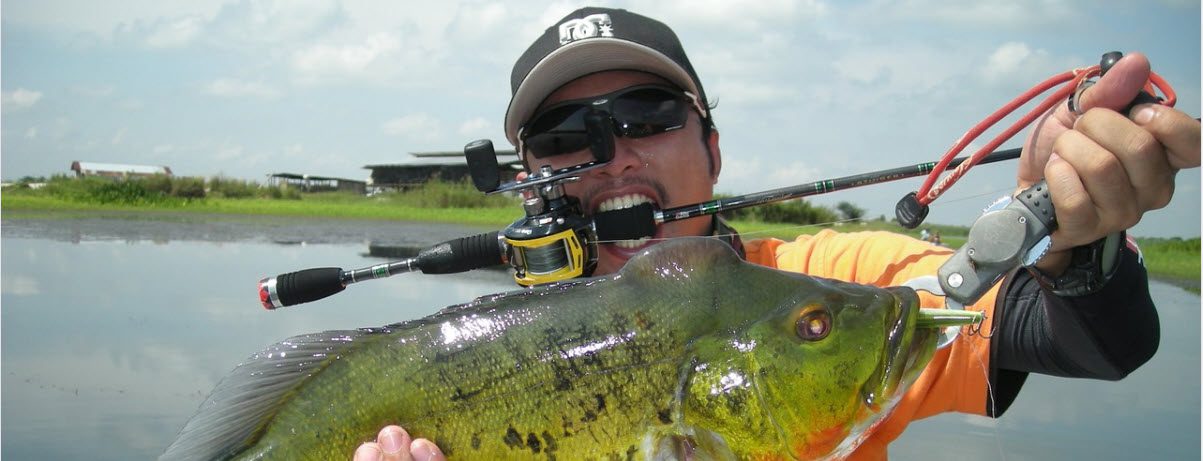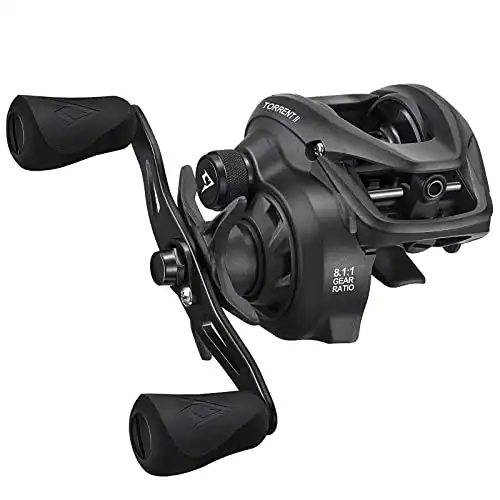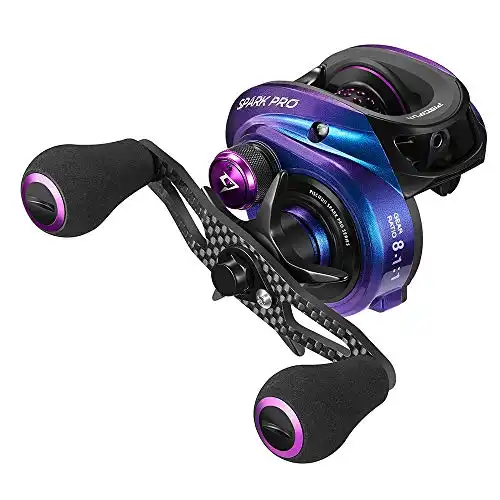Hey there my fellow fishing enthusiasts. Today we are going to take a look at my 3 best baitcaster reels for kayak fishing this year. I have to admit to never really having viewed baitcasters for kayak fishing as, to be honest, I have always found the old spinner reels to be more than adequate for my purposes.
It wasn’t until I watched a friend of mine recently use one whilst we were floating about, that I have looked into them a little more. You see we often chase a larger species called a Mangrove Jack which is a hard hitting and hard fighting fish that hides in the mangroves (hence the name) and base don my research it would appear that baitcasters were just made for this use.
I have always used my heavy boat reel for this purpose, but watching John cast and retrieve with ease with a light rig – and keep a good fish on the line – I am hooked. So let’s have a look at some options I have for a baitcaster on the kayak…
My 3 recommended baitcaster reels for kayak fishing
I will review these in more detail below but if you just want to get moving without all the carry on, my 3 are listed here for your convenience:
What should you be looking for?
Ok, so we are venturing into the old baitcaster vs spinning reel argument here and as you may know, I have always worked on the spinner (a.k.a egg beater) side of things. These are simple to use, easy to maintain, are generally light in weight and will work in most environments.
Baitcasters are generally accepted as being more suitable for experienced fisherman due to their tendency to tangle (bird’s nest) on casting. However, as I mentioned above, after watching John use his there are some definite advantages to them as well including:
- More accurate when casting.
- Longer casting capabilities.
- Can handle heavier line and lure/sinker weight.
- Can handle much bigger fish for their size than spinners.
So, if these are requirements that you have when fishing from your kayak (or you have an interest in them), I will give you a quick run through below on what to think about when looking for a good reel option for your needs. Some of this will determine your purchase and the rest is just an outline in case you have some personal preferences. Let’s check it all out…
Note: Fishing rods that are used with spinning rods are not interchangeable with baitcasters. This post is being written based on the assumption that you have a casting rod at the ready. If not, then maybe check out my post covering baitcaster rod and reel combos for kayak fishing.
Location
I am starting with the location as it can definitely have an effect on the type of fishing reel that you could choose and will determine your answers to many of the variants I have listed below – especially when we are dealing with baitcasters.
We have already discussed that baitcasters tend to be more accurate when casting and are also able to handle larger fish than spinners too so location will definitely have an influence on their use.
Some location considerations include:
- Holes: If there are any holes that you like to fish into then greater accuracy may be required.
- Rocks and other obstacles: Will you want to cast into them or over them? Baitcasters can generally cast a little further than spinners so again, this may be worth a look if longer casting is required.
- Current: Is there a strong tidal current running? If so, larger line and tackle may be needed.
- Wind: Windy waters are harder to cast in for obvious reasons.
- Mangroves etc.: As discussed, casting here will require accuracy.
There is more to this but from a general point of view, if you are constantly fishing in an area where you either need accuracy or are chasing larger species then a baitcaster may serve you well. That said, I think that the lighter the setup you can get for a kayak the better, which in general may lead you to a baitcaster on that advantage alone. We will discuss this in greater detail below …

Reels
For those of you who are still on the fence, I have discussed spinning reels in more detail in my post on kayak fishing reels for beginners. Below we will discuss the ins and outs of baitcaster reels…
Baitcaster Reels
Often referred to as a spincast reel as well, these are upside down models where the reel sits on top of, rather than underneath, the rod. Functionality can vary from the simple beginner models where the cover or closed face keeps all of the essential parts of the reel protected to the more complicated ones where casting speed etc. can be adjusted dependent upon the environment.
Baitcaster reels are usually described as being good for the more experienced angler who can manage the braking settings at each use. However, the base models here can be good for beginners as they simply press down on the thumb button on the back to cast the line. In my experience however, these do tend to tangle or ‘birds nest’ a little more than their spinning cousins.
Note: In this post and within my recommendations below, I am discussing the low profile baitcaster reels as they are most suitable for a kayak. Round baitcaster reels are the larger models that are predominately used on boats and for big game fishing.
Casting
Baitcasters release their line via the main spool which, once released by the press of a button or lever, rotates at high speed to let the line out. The line runs in a straight line which increases distance and accuracy as it is effectively unwound directly from the spool.
Composition
Baitcaster reels are mostly made from the same materials as the spinners – a corrosion-resistant metal, carbon fiber and/or aluminum body with variations of the following:
- Bearings – as with spinning reels, bearings are utilised within the reel for smooth casting and retrieval. .
- Rotation – Winding rotation ratios are also evident in baitcaster reels. This is usually set up to 6 or 7:1.
- Drag – The drag of a baitcaster is one of its real advantages over a spinning reel in that they can be set with greater sensitivity and are generally a lot stronger as well. This is why many who chase really big fish use a baitcaster over a spinning reel.
- Casing: Again, this is the part of the reel that contains the springs, levers, gear cogs etc. that make much of the stuff above work. As with the spinner, make sure any you purchase have everything included encased for ease of use and maintenance.
Brakes
Ok, so one of the main issues that many have with baitcaster reels is that they tangle much easier when the line is being cast. This is due to a phenomenon called ‘backlash’. Put simply, this is when the spool turns faster than the lure/sinker can pull the line out during casting and the line tangles.
In early models, the spool was slowed by placing your thumb onto the spool as it wound out and this took some practice. In modern reels however, this is managed via the implementation of brakes. There are a number of variations here including:
- Centrifugal Brakes: During the first part of the cast, the rod sends the weight (lure or sinker) out in a slingshot motion. Centrifugal brakes use gravity to adjust the spool speed to ensure it spins at the same rate as the cast. In this case, the brakes extend from the center of the spool running along a shelf in the centre of the reel to slow if down. These can be adjusted but in most reels, this is not a simple task.
- Magnetic Brakes: Magnetic brakes are another way of controlling spool speed with easier adjustment via a small dial on the side of the unit. As the dial is turned, magnets move closer or further away from the side of the spool – the closer they are, the more they can slow the spool. These work the same as the centrifugal brakes in that they are mainly designed to work during that first ‘whip’ of the cast and release once the spool slows over the casting duration.
- Spool Tension Adjustment: Most baitcaster reels also come with a spool tension adjustment. This is designed for use at the end of the cast when the lure or sinker hits the water (as opposed to centrifugal and magnetic brakes which operate in the first part of the cast). In simple terms, the tension adjustment stops the spool shaft at the same time that the tackle hits the water meaning excess line is not released.
None of this of course is to say that you can’t still use your thumb if that suits – or you have set your brakes or tension adjustment incorrectly – but these tools can definitely make the use of these reels much more enjoyable.

Spool Size
Spool size is what determines just how much line you can put onto your reel. As baitcasters can generally handle heavier line than spinners, and can cast further, the more line you can fit onto the spool the better. Baitcaster reel spool size is usually categorised as the length of line that can be loaded by line size.
For example, the reel may be specified as capable of loading “150 yards at 15lbs mono capacity – or 15/150” (slightly longer for braid). Some manufacturers will also stipulate maximum and minimum line weight limits as well.
Spools are usually made from high strength aluminium or stainless steel.
Other Influences
Unlike the spinning reel, there are not as many other influences to consider with a baitcaster. The handle and weight are obviously still a consideration and some do also come with a line holder. However, the handles are not as easily interchangeable as the other option although anti reverse settings can often be better managed on baitcasters as well.
FAQ
Are baitcaster reels good for the kayak?
Baitcaster reels are great for accuracy when fishing amongst structure or under Mangroves etc. This makes them perfect for the kayak where you often only get one chance to hit the right spot and there is not a lot of room to move around in.
What do I use?
For my kayak, I use a Shimano Caius HG150 baitcaster. It is lightweight and easy to use in a tight space with a ‘Super Free Spool’ that whilst certainly makes it cast smoothly, also appears to lead to more backlash issues as well.
The internal braking system is easily adjustable and the tension spool is extremely sensitive so once I managed to get it all sorted, I found it to be responsive and effective for the shorter casting needs that I use it for. It does appear to cast better with heavier sinkers and lures which I tend to not use so much in a kayak.
Here are its specs:
Reel
- Product Name: Shimano Caius HG150 baitcaster reel
- Spool Size: Mono 12/110, Braid 20/150
- Bearings: 3+1
- Ratio: 7.2:1
- Composition: Aluminum
- Drag: 5kg/11lb
- Brakes: Centrifugal VBS Braking System
My three recommendations broken down
So based on the information above, and my own experience, I recommend the following for beginners:
1. Piscifun Torrent Baitcasting Reel
I have chosen this first option based on the fact that it is the best I have seen for the casual or budget minded fisher. The reel is simple in design whilst maintaining decent casting adjustment capabilities with rust free build and maintenance options as well. It is a good, solid and durable product that is light to hold with specifications as follows:
Reel
- Spool Size: 10 lb/120 yd – 10 lb/195 yd (mono) or 30 lb/120 yd – 30 lb/145 yd (braid)
- Bearings: 5+1 shielded stainless steel
- Ratio: 5.3:1 or 7.1:1 (5.3:1 holds more line)
- Composition: Aluminum with reinforced CNC brass gear
- Drag: 4 carbon washer star drag on side (18Lb)
- Brakes: Magnetic – 5 x magnets
Other advantages include:
- Lightweight composition – (approx 8oz total).
- Double line winding shafts
- Easy access lubrication oil port
- Left and right-hand options available
Why have I chosen it?
This is a good little all round use reel for a great price. I like the lightweight design for a kayak with good anti-corrosion build for saltwater use. It will take a good range of line strength (up to 30lb) and should be able to handle both light and heavy sinker weight if the conditions require it.
2. Piscifun Spark Pro Baitcasting Reel
This next option is a great one for those wanting to do a bit more fishing and are looking for some extra smoothness and adjustability in their reel. In simple terms, it is just a little more rounded than the first option above with better bearing and braking specs for not a lot more in price. These specifications include:
Reel
- Spool Size: 7lb/109yds
- Bearings: 11+1
- Ratio: 6.6:1 or 8.1:1
- Composition: Aluminum with anodized 7075 Aircraft grade aluminum main gear
- Drag: Oversized carbon fiber star drag on side (16.5Lb)
- Brakes: Magnetic – 8 x magnets
Other advantages include:
- Ultra Lightweight composition – (approx 7oz total)
- Double shaft supported line wind
- Carbon handle and EVA knobs
- Left and right-hand options available
Why have I chosen it?
This one is very close to the perfect baitcaster reel for kayak fishing and the one I would choose here. I love the lightweight specifications and it would also handle most kayak conditions including where accuracy or some heavier weights are needed. My only concern here is around the lower line weight and length capabilities mentioned however if you are looking to jig some lighter lures whilst drifting, then this one may suit that better anyway.
3. SHIMANO TRANX, LowProfile Baitcasting Fishing Reel
The third option I have chosen is a little more expensive but for the kayak fisherman with experience in using baitcasters, it is a well-known and trusted brand with all of the extra setting requirements that make it a great all round option. It has the ability to handle just about anything that you could catch in a kayak in both open and closed waters with extreme durability via its “coreprotect water resistant technology”. Its specs include:
Reel
- Spool Size: Braid line cap: 40/195; 50/190; 65/125 – mono line cap: 12/230; 14/180; 17/150
- Bearings: 5+1
- Ratio: 5.8:1 or 7.6:1
- Composition: HAGAN body made of highly rigid aluminium and magnesium
- Drag: Cross carbon Star drag on side (18 – 22Lb)
- Brakes: Variable brake system using centrifugal force vs magnets
Other advantages include:
- Oversized gears designed to handle large baits/lures
- Massive X-ship and heg technologies cranking power
- Available in left and right-hand options
Why have I chosen it?
This reel is a great one for those who looking for a little quality over price or for those who like ultimate control of settings. The specifications make it suitable for all types of kayak fishing both on and off shore whether using bait or lures. The reel is extremely versatile able to handle pretty much anything that can be thrown at it and would not look out of place for use on an ocean going boat as well.
|
4.5
|
4.5
|
4.5
|
|
$39.99
|
|
$299.99
|
Conclusion
And there it is – my 3 best baitcaster reels for kayak fishing this year. I hope it has been helpful and as usual, please let me know of your experiences with them.
Also, please do not hesitate to comment below if you have any questions, concerns, corrections or would like me to check anything else out for you.
Until next time
Have fun
Paul



![Shimano Fishing Tranx 300 A Low Profile Reels [TRX300A]](https://beachandfishing.com/wp-content/uploads/2022/11/31R4TX8JxcL._SL500_.webp)
